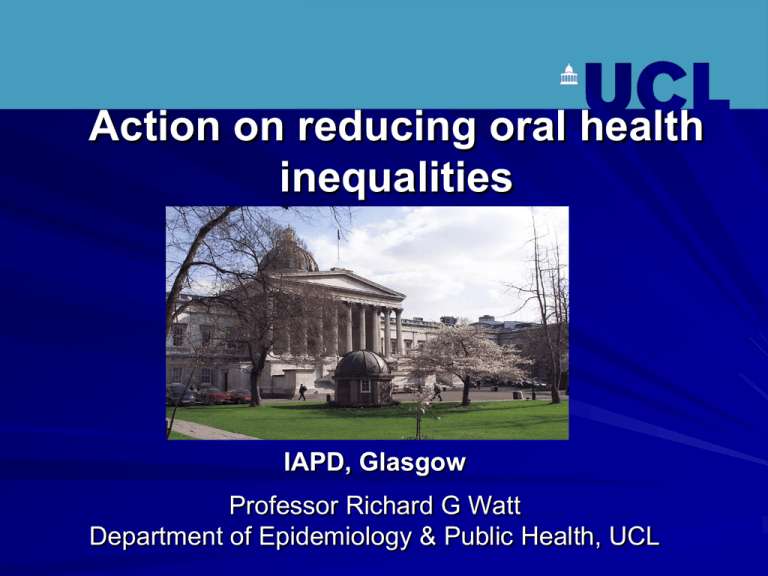Action on reducing oral health inequalities IAPD, Glasgow
advertisement

Action on reducing oral health inequalities IAPD, Glasgow Professor Richard G Watt Department of Epidemiology & Public Health, UCL Health inequalities Key public health challenge for 21st century HEALTH DIFFERENCES INEVITABLE POTENTIALLY AVOIDABLE ACCEPTABLE UNACCEPTABLE, UNFAIR INEQUALITIES Dahlgren & Whitehead (1991) Life expectancy at birth (men) UK, Glasgow (Calton) 54 India 62 US, Washington D.C. (black) 63 Philippines 64 Lithuania 65 Poland 71 Mexico 72 Cuba 75 US 75 UK 77 Japan 79 US, Montgomery County (white) 80 UK, Glasgow (Lenzie N.) 82 Sources: WHO World Health Statistics 2007; Hanlon, Walsh & Whyte 2006; Murray et al. 2006 Oral health inequalities Distribution of Oral Disorders Globally (age-standardized, both sexes, DALYs per 100,000) Source: IHME, Global Burden of Diseases (2013) Avg. number of decayed (dt), missing (mt), filled (ft), teeth for 5 year old children in Islington 2003/04 by school. ( Source:BASCD 2004) Average of dt Average of mt 4 3.5 3 Avg.dmft 2.5 2 1.5 1 0.5 0 School Average of ft Oral health inequalities: Latest Findings from CDHS 2015 Inequalities: behaviours & impact • Oral health behaviours varied by SES eg – Toothbrushing (72% vs 82%) – Regular dental attendance (66% vs 86%) – Sugar drinks (13% vs 26%) • Significant variation by SES on subjective impacts of oral disease eg – Pain (27% vs 11%) – Two or more difficulties (39% vs 28%) Determinants of health inequalities Oral health determinants Bio-medical perspective – Oral hygiene – Sugars consumption – Smoking and alcohol – Exposure to fluoride – Use of dental services Social determinants of health The main determinants of health Complex influences on health Wider influences Lifestyle factors Health individuals & communities Implications for health improvement What does the evidence show? Effective policies to reduce inequalities Structural changes in environment Legislative and regulatory controls Fiscal policies Starting young Community action Improving accessibility of services Prioritizing disadvantaged population groups (WHO 2003; Bambra et al., 2010; Lorenc et al., 2012) Ineffective interventions – increase inequalities Information based campaigns (mass media programmes) Written materials (leaflets and posters) Campaigns reliant on people taking the initiative to opt in Health education campaigns designed for the whole population (MacIntyre, 2007; Lorenc et al., 2012) Inverse prevention law Even when interventions are successful at improving health across the population, they may increase health inequalities. (Gordon et al., 1999; Lorenc et al., 2012) Scottish dental health education intervention Plaque index=0 No bleeding 45 85 40 80 35 30 75 25 20 70 15 10 65 5 0 60 Before intervention 1 month after Non-deprived 4 month after Deprived Before intervention 1 month after Non-deprived 4 month after Deprived (Schou L, Wight C: Does dental health education affect inequalities in dental health? Community Dent Health 1994, 11(2):97-100.) Policy Levels for Tackling Inequalities in Health Role of clinical dental teams Understanding needs of local population Importance of professional training – Key skills partnership working communication; advocacy; lobbying Priority focus on early life – foundations Ensuring equity of access & outcomes Developing a team approach – skill mix Delivering evidence based clinical prevention – targeted to disease risk Partnership working with local agencies & services Dentists as local employer – Recruitment & training of local people – Career development Supporting wider action through advocacy & lobbying eg dental associations Watt et al., 2014 National oral health prevention policies Dental Public Health ucl.ac.uk/dph Public health approach www.ucl.ac.uk/dph Upstream - downstream interventions National &/or local policy initiatives ‘Upstream’ Healthy Public Policy Legislation/Regulation Fiscal Measures Healthy Settings- HPS Community Development Training other professional groups Media Campaigns School dental health education Chair side dental health education ‘Downstream’ Watt, CDOE (2007) Health Education & Clinical Prevention Clinical Prevention Conclusions Global challenge of addressing oral health inequalities Need to recognise limitations of biomedical preventive model Time to adopt a social determinants approach in oral health policy Thank you for your attention r.watt@ucl.ac.uk www.ucl.ac.uk/dph


